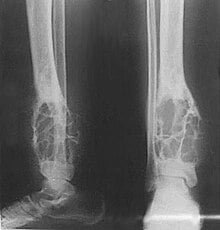Adamantinoma Overview
Adamantinoma is a rare type of bone cancer that primarily affects the tibia, the long bone in the lower leg. It accounts for less than 1% of all bone tumors and typically occurs in young adults, although it can also be found in older individuals. Adamantinoma is known for its slow growth and potential to recur or metastasize if not treated effectively. At Fight Bone Tumors, Dr. Kishore B Reddy and our expert team offer specialized care for patients with adamantinoma, using state-of-the-art diagnostic tools and personalized treatment plans to manage this rare cancer.
Symptoms:
The symptoms of adamantinoma can be subtle initially but tend to become more pronounced as the tumor grows. Common signs include:
- Persistent Pain: Often localized to the affected area, particularly the shin.
- Swelling or Lump: Noticeable over the site of the tumor.
- Tenderness: The area around the tumor may be sensitive to touch.
- Limited Range of Motion: Especially if the tumor is near a joint.
- Pathological Fractures: Bones weakened by the tumor may break more easily.
- Fatigue and Weight Loss: Common in more advanced stages of the disease.
Early detection and treatment are crucial to prevent complications and improve outcomes.
Diagnosis:
Diagnosing adamantinoma involves several tests to confirm the presence of the tumor and assess its characteristics:
- Physical Examination: Initial assessment to evaluate symptoms and overall health.
- Imaging Tests: X-rays, MRI, and CT scans to visualize the tumor, determine its size, and understand its relationship with surrounding structures.
- Biopsy: A sample of the tumor tissue is taken and examined under a microscope to confirm the diagnosis and determine the tumor’s characteristics.
Accurate diagnosis is essential for developing an effective treatment plan.

Treatment Options:
Treatment for adamantinoma focuses on removing the tumor, preserving function, and preventing recurrence. Our approach includes:
Surgery:
- Wide Excision: Removing the tumor along with a margin of healthy tissue to ensure complete removal and reduce the risk of recurrence.
- Limb-Sparing Surgery: Preserving the limb’s function while removing the tumor, whenever possible.
- Reconstructive Surgery: Using bone grafts or prosthetic implants to reconstruct the bone and restore function after tumor removal.
Radiation Therapy:
- Used in cases where complete surgical removal is not feasible or as an adjunct to surgery to target residual cancer cells.
Chemotherapy:
- Not typically effective for adamantinoma, but may be considered in certain cases where the tumor has metastasized.
Our multidisciplinary team collaborates to develop personalized treatment plans aimed at achieving the best possible outcomes for our patients.
Support and Rehabilitation:
Dealing with adamantinoma involves more than just medical treatment. We offer comprehensive support services to help patients and their families through this journey:
Physical Therapy:
- Essential for recovery post-surgery, aiding in regaining strength and mobility.
Emotional Support:
- Counseling and support groups to address the emotional and psychological impacts of living with adamantinoma.
Nutritional Guidance:
- Tailored dietary plans to support overall health and recovery during and after treatment.
Follow-Up Care:
- Regular check-ups to monitor for recurrence and manage any long-term side effects of treatment.
FAQ's
Adamantinoma is a rare type of bone cancer that primarily affects the tibia, the long bone in the lower leg. It is known for its slow growth but can recur or metastasize if not treated effectively.
Common symptoms include persistent pain, swelling or a lump, tenderness, limited range of motion, pathological fractures, and fatigue and weight loss in advanced stages.
Diagnosis typically involves a physical examination, imaging tests (X-rays, MRI, CT scans), and a biopsy to confirm the diagnosis and determine the tumor’s characteristics.
Treatment options may include surgery (wide excision, limb-sparing surgery, reconstructive surgery), radiation therapy, and in certain cases, chemotherapy.
Wide excision surgery involves removing the tumor along with a margin of healthy tissue to ensure complete removal and reduce the risk of recurrence.
Yes, potential side effects can include pain, swelling, risk of infection, and challenges related to rehabilitation post-surgery. Specific treatments may have their own unique side effects.
Managing side effects can involve rest, physical therapy, proper nutrition, pain management medications, and emotional support through counseling or support groups.
We offer physical therapy, emotional support, nutritional guidance, and regular follow-up care to monitor for recurrence and manage long-term side effects.
With early detection and appropriate treatment, many patients can achieve long-term remission. The prognosis depends on the tumor’s size, location, and the effectiveness of the treatment.
You can schedule a consultation by calling us at +91 9032027279 or emailing info@fightbonetumors.com. Our team is here to provide personalized care and support.





